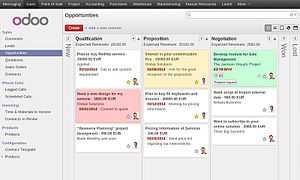Odoo
|
| |
 | |
| Original author(s) | Fabien Pinckaers |
|---|---|
| Developer(s) | Odoo S.A. |
| Stable release | 8.0 / September 18, 2014 |
| Preview release | current master version / daily |
| Written in | Python, JavaScript, XML |
| Operating system | Linux, Windows, Unix, Mac OS X |
| Type | ERP, CRM, Accounting, CMS |
| License | AGPL |
| Website |
www |
Odoo is a suite of open-source business apps written in Python and released under the AGPL license. It is used by 2 million users worldwide[1] to manage companies of all different sizes. The main Odoo components are the server, 260 core modules (also called official modules) and around 4000 community modules.[2]
Odoo was formerly known as OpenERP until May 2014. It was rebranded because version 8 of the software introduced apps including website builder, e-commerce, point of sale and business intelligence. The software conforms to standard expectations of ERP systems, while providing additional modules beyond the coverage of traditional ERP systems.
The official Odoo apps are organized in 6 groups:
- Front-end apps: website builder, blog, e-commerce
- Sales management apps: CRM, point of sales, quotation builder
- Business operations apps: project management, inventory, manufacturing, accounting and purchase
- Marketing apps: mass mailing, lead automation, events, survey, forum, live chat
- Human Resources apps: employee directory, enterprise social network, leaves management, timesheet, fleet management
- Productivity apps: business intelligence, instant messaging, notes
The software is actively programmed, supported, and organized by Odoo S.A. Odoo is similar to many open source projects where customized programming, support, and other services are also provided by an active global community and a network of 500 official partners.
Business Applications
Odoo s.a. provides a web site referencing the officially supported modules as well as community modules.[3] Community modules can be referenced for free as long as they respect the open source licence of Odoo. As of June 2014, the number of Odoo apps reached more than 4000.[3]
Official apps include:
- Sales Management
- Purchase Management
- Customer Relationship Management
- Project Management
- Warehouse Management
- Manufacturing
- Accounting & Finance
- Content Management
- E-commerce
- Asset Management
- Human Resource Management
- Fleet Management
- Event Management
- Social Network
- Point of Sale
- Knowledge and Document Management
- Calendar
- Expense Management
- Time Tracking
- Employee Appraisals
- Manufacturing Resource Planning
- Portal
- Employee Directory
- Address Book
- Recruitment Process
- Payroll Management
Architecture
Odoo uses a Service Oriented Architecture as a software architecture design pattern.
Web Application Architecture
The most recent versions of Odoo (including version 7) are mostly implemented as a web application. Odoo includes an application server/web server (known as the Odoo Server) that focuses on ERP business logic, stores data through an interface with a database, and web client for web browsers access. The server and business logic portion of Odoo is primarily written in the Python programming language. The web client is primarily written in JavaScript.
Modules
Business features are organized into modules. A module is a folder with a pre-defined structure containing Python code and XML files. A module defines data structure, forms, reports, menus, procedures, workflows, etc... Modules can also contain web components written in JavaScript.
Database
Odoo uses PostgreSQL as the database management system.
Source code and contributions
Odoo source code is hosted on the GitHub project hosting service, using the Git distributed revision control system.[4] The documentation is published on a separate website.[5]
Development environment
Module development mainly relies around editing Python and XML files. Some application logic (i.e. workflows and data structure) can be changed through the client interface using a developer mode.
Release history
| Program name | Version | Launch date | Significant changes |
|---|---|---|---|
| Tiny ERP | 1.0 | February 2005 | First GPL release |
| 2.0 | May 2005 | ||
| 3.0 | September 2005 | ||
| 4.0 | December 2006 | ||
| OpenERP | 5.0 | April 2009 | |
| 6.0 | January 2011 | First AGPL release,[7] and first web client | |
| 6.1 | February 2012 | First Ajax web client, discontinued GTK client | |
| 7.0 | December 22, 2012 | Improved web client and usability | |
| Odoo | 8.0 | September 18, 2014 | Support for CMS: Website builder, e-commerce, point of sale and business intelligence |
| 9.0 | July, 2015 [1] | First LGPL release[8] | |
See also
- Comparison of accounting software
- List of free and open source ERP packages
- List of free and open source software packages concerning finance
- Tryton, a fork of TinyERP version 4.2.
References
External links
| Wikimedia Commons has media related to OpenERP. |